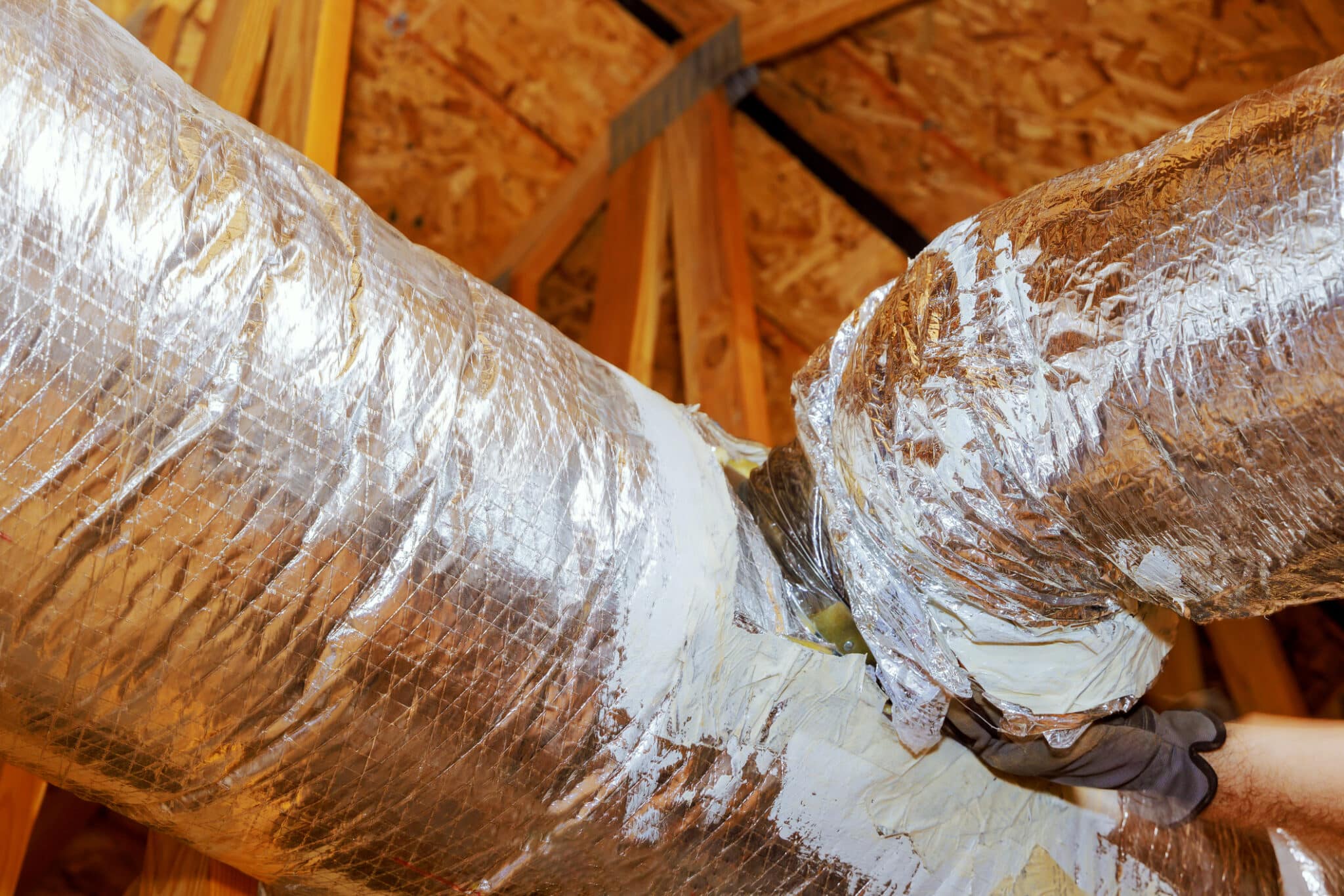Ensuring your home’s HVAC system runs efficiently is crucial for comfort, especially in areas like Lakeside, CA, and La Mesa, CA, where temperatures can vary. One key aspect of maintaining this efficiency is to properly insulate ductwork. This process not only helps in regulating your home’s temperature but also plays a significant role in reducing energy consumption. By focusing on this aspect, homeowners can enjoy a more comfortable living environment and potentially lower utility bills.
Insulating ductwork might seem daunting, but it’s a vital step toward achieving an energy-efficient home. It prevents the loss of cool or warm air as it travels through your ducts, ensuring that your HVAC system doesn’t work harder than it needs to. This is particularly important in Lakeside, where the climate demands a well-functioning system year-round. By addressing this, residents can make a positive impact on their home’s overall energy performance.
In La Mesa, the benefits of such an initiative extend beyond just energy savings. Properly sealed and insulated ductwork can significantly improve indoor air quality by reducing the infiltration of pollutants and allergens. This is a boon for homeowners, providing a healthier living environment for families. It’s a step that underscores the importance of taking care of the less visible parts of our homes for overall well-being.
Starting on the journey to insulate ductwork is a proactive measure that homeowners can take to enhance their home’s efficiency and comfort. It’s a project that not only benefits the individual household but also contributes to the broader goal of energy conservation in our communities. As we delve deeper into the specifics, remember that the goal is to create a more sustainable, comfortable home environment in Lakeside and La Mesa.
Understanding the Importance of Ductwork Insulation
To insulate ductwork effectively, homeowners must first understand the role it plays in their HVAC system’s efficiency. Proper insulation ensures that air traveling through the ducts maintains its temperature, preventing energy waste. This is especially crucial in Lakeside, where fluctuating temperatures can challenge home comfort. By keeping the ductwork well-insulated, residents can enjoy consistent indoor climates without overburdening their HVAC systems.
Sealing ducts is equally important and goes hand in hand with insulation. Small leaks or gaps in the ductwork can lead to significant energy losses, as heated or cooled air escapes before reaching its intended destinations. Homeowners in La Mesa can address this by using mastic sealant or metal tape to seal these openings securely. This step not only enhances the efficiency of the HVAC system but also contributes to a more environmentally friendly home.
After sealing, choosing the right insulation material is key to maximizing the benefits. There are various types of insulation specifically designed for ductwork, each with its own advantages. Homeowners should select a material that suits their home’s specific needs, taking into account factors such as durability and effectiveness. Properly insulating ductwork ensures that the HVAC system operates at peak efficiency, providing comfortable temperatures year-round.
Finally, regular checks and maintenance of ductwork insulation should not be overlooked. Over time, insulation can degrade or become dislodged, reducing its effectiveness. Homeowners should periodically inspect their ductwork, especially after extreme weather conditions, to ensure the insulation remains intact and functional. This proactive approach helps maintain optimal HVAC system performance, ensuring a comfortable and energy-efficient home environment in both Lakeside and La Mesa.

How to Identify Leaky Ductwork in Your Home
Identifying leaky ductwork is a crucial step before you insulate ductwork to ensure your HVAC system’s efficiency. Start by visually inspecting the ducts for any signs of wear and tear, such as holes or loose connections. This simple action can reveal areas where heated or cooled air might be escaping, particularly important in Lakeside, CA, where maintaining a consistent home temperature is essential.
Next, feel around the duct joints and connections when your HVAC system is running. Air leaks will feel like a light breeze or draft. This hands-on approach helps homeowners in La Mesa, CA, pinpoint the exact spots needing sealing. By addressing these leaks, you ensure that the insulation process is not in vain, securing a more efficient system.
Another method involves using incense or a smoke pen near the ductwork while the system is active. Watch how the smoke behaves, if it wavers or is sucked into the duct joints, you’ve found a leak. This technique is effective and easy to perform, offering a clear visual cue of air escaping from your ducts.
Finally, consider hiring a professional for a thorough inspection if you’re unsure about your ductwork’s integrity. They use specialized tools to detect even the smallest leaks, a wise decision for ensuring your home in either Lakeside or La Mesa is as energy-efficient as possible. With leaky areas identified and sealed, insulating your ductwork becomes a more fruitful endeavor, enhancing your home’s comfort and HVAC efficiency.
Tools and Materials Needed to Insulate Ductwork
Before embarking on the task to insulate ductwork, gathering the right tools and materials is crucial. Homeowners will need foil tape or mastic sealant for sealing leaks, a staple gun for attaching insulation, and the insulation material itself, which should be specifically designed for HVAC ducts. Additionally, a utility knife will be necessary for cutting insulation to the right sizes and shapes. Having these items on hand ensures a smooth start to the project, facilitating a more efficient workflow.
Next, it’s important to choose the correct type of insulation for your ductwork. Reflective insulation is ideal for attics or garages in Lakeside, CA, where exposure to direct sunlight can significantly increase temperatures. In contrast, fiberglass insulation might be better suited for indoor areas, providing excellent thermal resistance and soundproofing benefits. Understanding the specific needs of your home’s environment will guide you in selecting the most effective insulation material.
Properly preparing the ductwork before applying insulation is another critical step. This involves cleaning the surfaces of the ducts to ensure the foil tape or mastic sealant adheres securely. For residents in La Mesa, CA, this might mean removing dust or grease that has accumulated over time. A clean surface not only enhances the bond but also improves the overall effectiveness of the insulation.
Finally, applying the insulation correctly is key to maximizing energy efficiency. Start by sealing all visible leaks with your chosen sealant, then measure and cut the insulation material to fit around the ductwork snugly. Secure it in place with the staple gun, making sure there are no gaps or loose areas. This attention to detail will help maintain a consistent temperature within the ducts, ensuring your HVAC system operates as efficiently as possible.
Step-by-Step Guide to Sealing Ductwork Leaks
After sealing and choosing the right insulation, the next step is to focus on sealing ductwork leaks effectively. Begin by applying mastic sealant or foil tape over any cracks or gaps you identified earlier. This ensures that the air inside the ducts doesn’t escape, making your HVAC system more efficient. It’s a straightforward process that can significantly impact your home’s energy use in Lakeside, CA.
In La Mesa, CA, it’s equally important to ensure that the sealant has properly dried and set. This might require waiting a few hours or according to the product’s instructions. Once the sealant is dry, you can proceed with confidence, knowing that the air will now stay within the ducts, improving your system’s efficiency and your home’s comfort.
Next, test the ductwork for any missed leaks by turning on the HVAC system and feeling for drafts around the sealed areas. If you find no air escaping, you’ve successfully sealed the ducts. This step is crucial for verifying the effectiveness of your work and ensuring that your efforts to insulate ductwork will not be undermined by lingering leaks.
Finally, reinforce the sealed areas with additional insulation to maximize energy efficiency. Wrapping these spots with an extra layer of insulation helps maintain the desired temperature within the ducts. This added measure can make a noticeable difference in the overall performance of your HVAC system, keeping your home comfortable throughout the year.
Choosing the Right Insulation for Your Ductwork
Choosing the right insulation for your ductwork is a key step in ensuring your HVAC system works as efficiently as possible. Reflective insulation is a great choice for areas in Lakeside, CA, that get a lot of sunlight, as it helps reflect heat away from the ducts. This type of insulation is especially useful in attics or garages where temperatures can soar, making your system work harder than necessary.
In contrast, for indoor ductwork, especially in places like La Mesa, CA, fiberglass insulation might be more appropriate. It offers excellent thermal resistance and also has the added benefit of sound dampening. This can be particularly beneficial in maintaining a quiet and comfortable home environment, as well as ensuring that your HVAC system doesn’t lose efficiency through heat gain or loss.
It’s important to consider the specific needs of your home’s location and the layout of your HVAC system when selecting insulation. Homes in cooler areas may benefit from thicker insulation to retain heat, while those in warmer climates might prioritize materials that block out heat. Each type of insulation comes with its own set of advantages, so understanding your home’s requirements is crucial for making an informed decision.
Finally, don’t overlook the importance of professional advice when looking to insulate ductwork. A professional can offer insights into the best type of insulation for your specific situation, taking into account factors like your home’s age, the condition of existing ductwork, and local climate conditions. Their expertise can guide you towards the most effective insulation choice, ensuring your HVAC system operates at peak efficiency.
Professional vs. DIY: When to Call the Experts
Deciding between a professional service and a DIY approach to insulate ductwork can be challenging. Homeowners in Lakeside, CA, might feel confident tackling home improvement projects. Yet, insulating ductwork requires precise skills and knowledge to ensure it’s done correctly. Making a mistake could lead to inefficiencies that negate the benefits of insulation, suggesting that sometimes calling in experts is the prudent choice.
For those in La Mesa, CA, considering the DIY route, it’s important to assess your own abilities and the complexity of your HVAC system. Simple sealing might be within the capabilities of a handy homeowner. However, insulating ductwork often involves navigating tight spaces and requires an understanding of the right materials for different environments. Without this expertise, homeowners might not achieve the desired improvement in energy efficiency.
On the other hand, professionals bring a wealth of experience to the task. They can identify less obvious leaks and inefficiencies in the ductwork that a layperson might miss. Their expertise ensures that the insulation is applied correctly, maximizing the potential for energy savings. This level of detail contributes significantly to the overall comfort and efficiency of a home, making the investment in professional services worthwhile.
Ultimately, the decision to insulate ductwork with a DIY approach or call in the experts depends on several factors. These include the homeowner’s skill level, the complexity of the project, and the importance of ensuring it’s done right the first time. For those unsure about their ability to seal and insulate ductwork effectively, consulting with a professional can provide peace of mind and ensure that the job contributes positively to the home’s energy efficiency and comfort.

Benefits of Properly Insulated Ductwork
Insulating ductwork significantly enhances a home’s energy efficiency, leading to a more comfortable living environment. In Lakeside, CA, where temperatures can fluctuate, this process ensures that air maintains its temperature as it moves through the system. This efficiency reduces the workload on HVAC units, allowing them to operate more effectively. Consequently, homeowners can enjoy a consistent indoor climate without excessive strain on their systems.
Moreover, properly insulated ductwork contributes to a healthier home atmosphere. By sealing and insulating ducts, residents in La Mesa, CA, can minimize the infiltration of outdoor pollutants and allergens. This improvement in air quality is especially beneficial for families, creating a safer and more comfortable living space. It underscores the importance of addressing not just the visible aspects of home maintenance but also the hidden ones.
The environmental impact of insulating ductwork cannot be overlooked. By optimizing the efficiency of HVAC systems, homeowners play a part in reducing overall energy consumption. This conservation effort not only benefits individual households in Lakeside but also contributes to broader environmental sustainability. It’s a proactive step towards minimizing one’s carbon footprint, reflecting a commitment to a healthier planet.
Lastly, the longevity of HVAC systems is significantly improved with proper duct insulation. In La Mesa, CA, where the demand on heating and cooling systems can be high, this maintenance task helps prevent premature wear and tear. Homeowners can thus avoid frequent repairs and replacements, ensuring their systems run smoothly for years. This benefit, coupled with the enhanced comfort and efficiency, makes insulating ductwork a wise choice for any homeowner.
Frequently Asked Questions
What materials are needed to seal ductwork?
To seal ductwork effectively, homeowners need mastic sealant or aluminum foil tape. These materials ensure a tight seal on joints and seams. For gaps larger than 1/4 inch, use mesh tape with mastic. Remember, using the right materials is crucial to insulate ductwork efficiently and enhance your HVAC system’s performance.
How do you prepare ductwork for insulation?
Before insulating ductwork, cleaning the surface is essential. Remove any dust or debris to ensure a smooth application. Next, repair holes or tears with a high-quality sealant. This step ensures the insulation adheres properly and enhances the efficiency of your HVAC system.
How often should you insulate ductwork in Lakeside?
In Lakeside, it’s best to check and possibly update your ductwork insulation every few years. This frequency ensures your HVAC system runs efficiently. Over time, insulation can degrade, affecting your home’s temperature control. Regularly assessing your insulation helps maintain optimal energy use and comfort in your home.
What are the benefits of sealing ductwork?
Sealing ductwork efficiently boosts your HVAC system’s performance, leading to improved air quality in your home. It prevents dust and allergens from entering the system, ensuring cleaner air circulation. Additionally, it reduces the strain on your HVAC, which can extend its lifespan. By improving efficiency, sealing also helps maintain consistent temperatures throughout your home, enhancing comfort.
Can you insulate ductwork in older homes?
Absolutely, older homes can benefit from having their ductwork insulated. This process enhances heating and cooling efficiency, leading to more consistent indoor temperatures. It also plays a key role in reducing energy usage, making your HVAC system work less hard. By insulating ductwork, homeowners in older properties can enjoy improved comfort and energy efficiency.



















